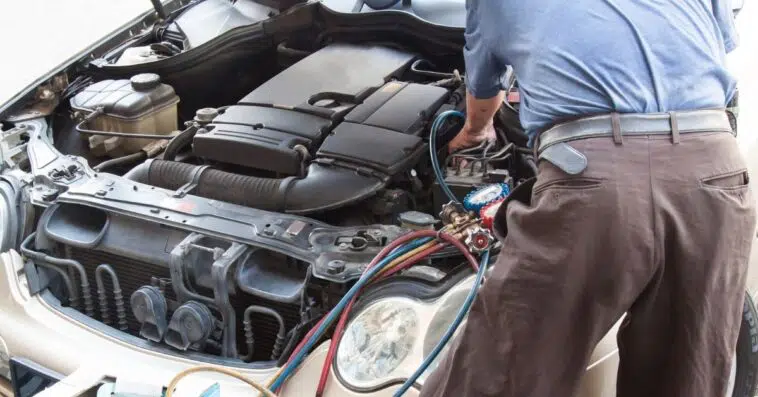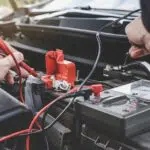To successfully remove Freon from car at home is not hard. In fact, you do not need to be a car mechanic to execute this successfully. However, it is essential to ensure you are keen.
One of the things that will shock you is that many people who own cars can easily remove Freon from the cars at the comfort of their homes. You can do this quickly.
In the process of removing Freon from the car at your home, you will require an AC recovery machine. An AC recovery machine will easily recover and recycle cooling substances in the car. When the machine recycles and removes refrigerant, it is done.
Let us have a look at the simple process to release Freon from your car AC.
TABLE OF CONTENTS
What Is A Freon?
Freon is the refrigerant that cycles between liquid and gas phases and regulates the temperature of your car.
Freon is a working fluid created for a car’s air conditioning system, similar to the motor oil and radiator coolant.
Both Freon and refrigerant are the same thing. Refrigerant is a carefully prepared combination used solely to convert hot air to cool air.
How Does Freon Function?
Freon is used in car air conditioners to cool the air. We already know that Freon is a type of HCFC (hydrochlorofluorocarbon) gas.
The Freon is pressurized by the compressor, converting it from a gas to a liquid. Your automobile may shake and vibrate due to problems with the AC compressor.
This pressure difference enables the system to generate cool air, which is then circulated throughout the vehicle’s cabin.
Unfortunately, much of the time, due to a lack of Freon, automotive air conditioners are unable to blow cold air, and the car may become hot when the air conditioner is turned on.
How To Successfully Remove Freon From The Vehicle At Home
An AC recovery machine is required to remove Freon from the vehicle at home.
The cooling substance that is found in the car can be recovered and recycled using AC recovery equipment. It’s finished when this equipment recycles and eliminates the refrigerant.
Removing Freon From A Car In A Safe Manner
First, put on your safety gear. It’s ideal if you take necessary precautions when expelling Freon from your vehicle. Not just for this project. Anything you do in the vehicle must be done safely.
- Put on hand gloves and safety eyewear before taking any action.
- Check the car’s Freon level (if possible).
- You will require assistance throughout the procedure. As a result, bear that in mind.
- After removing the Freon from the vehicle air conditioner, turn the compressor off.
- Confirm if the car is not on.
Step 1: Locate the Low-Pressure Service Port
A low-pressure service port is normally positioned between the compressor and the evaporator on the bigger diameter air conditioner line.
A black or blue plastic cap is usually found on the low side or even on the low-pressure service port.
To begin, locate the compressor. A compressor closes the radiator at the car’s front is driven by the fan belt.
Following the line from the air conditioner compressor to the evaporator is the next step.
Behind the dash, near the firewall, is the evaporator, also right beneath the windshield. This line typically has a low-pressure service port with a blue or black plastic cap that must be removed.
The low-pressure service port is not always located on the same line in each vehicle; in other cases, the service port is located directly on the A/C compressor.
So that you are aware of the location of your low-pressure service port, it’s time to connect the service hoses from the recovery machine to the service ports on the air conditioner system.
Step 2: Begin The Recovery Machine
You should have found the low-pressure service port and attached the recovery machine to an air conditioner’s service ports, hopefully.
Run the recovery machine to remove non-condensable gases and Freon vapor from the car’s air conditioning system. Even so, some of the cooling ingredients will be in the form of liquid.
Allow a recovery machine more time to adjust to the system’s pressure, and the liquid will condense into vapor.
This is because the internal pressure of the Freon has been exceeded. When the vehicle’s system is empty, the recovery machine will turn off automatically.
Step 3: Turn Off And Disconnect The Recovery Machine
Disconnecting the recovery machine from a service port is the final step in removing Freon from a car’s air conditioning system.
Before disconnecting a recovery machine, remember to close the server hose valves.
Some older kinds of recovery machines, which are primarily used to remove R-12 Freon, require shutting off valves on a hose.
However, with R-134a Freon, one gets a rapid detaching system due to common refrigerant loss.
What Should You Know Before Getting Freon Out Of Your Car?
You now know how to remove your car’s Freon. If you keenly follow these basic steps, you will be OK. Then getting rid of Freon will be a breeze.
Here are a few things to keep in mind:
- If any Freon is left in the car’s air conditioner, do not detach any hoses since Freon is harmful to both you and the environment.
- In certain states and countries, releasing Freon into the air without a valid reason is unlawful. Freon must be appropriately disposed of.
- Some jurisdictions require EPA certification before allowing Freon to be released from automobile air conditioners.
- If your area has a law requiring a certificate, you must not remove the Freon on your own. After all, we must constantly follow the law.
Is It Possible To Remove Refrigerant From The Car’s Air Conditioning?
When removing or recharging the refrigerant from the air conditioner, precision is essential. Even a small amount of additional refrigerant or an overloaded air conditioner can be a major issue.
Therefore, always be cautious when working with an automobile air conditioning system.
Many experts and professional vehicle mechanics discussed this at length and provided a variety of responses.
If this is your first time, you should have an expert remove the Freon from the automobile, which has done it before at home.
Removing refrigerant from a car’s air conditioner is entirely unlawful due to the combustible issue and environmental obligation.
However, if you do it professionally and feel safe and secure, you can do it in your garage.
You should always be extra cautious with your automobiles.
If you are concerned about the car being harmed, you should take it to a professional repair shop or a Freon removal expert with a Freon removal license.
You delegate total responsibility to a specialist by doing so.
How To Discharge Car AC At Home
Before we begin, I would like to point out that this is only achievable through a workaround. The refrigerant is stored in the evaporator portion until you are ready to reload.
This will save you both money and time that would otherwise be spent renting and setting up equipment.
So here we go:
- Turn off the inside thermostat.
- Find the low-pressure side of the refrigerant and also the compressor’s suction side. The latter can be found in the condensing unit. But, again, it’s up to you to make the connection between these two.
- On the low-pressure side of the condensing unit, close the service valve with your wrench. Depending on the valve, you may need a hex key and not a wrench.
- Now, close the service valve a tad bit on the high-pressure side. Do not completely close it. Allow the hex key to remaining in its current location.
- Now concentrate on the compressor, use a low-voltage jumper to turn it on.
- As the low-pressure valve empties, keep an eye on it.
- As soon as the vacuum is reached, close the service valve immediately.
- Finally, turn off the compressor. (Opposite of step 5).
You are finished!
Note: You must complete the final steps quickly (From process 7 to 8).
Delays in these stages may cause your compressor to break down.
As a result, ensure that you are focused and speedy. If you need assistance with any of the processes, have a family member or friend accompany you.
Removing refrigerant from a car air conditioner is a straightforward procedure that does not necessitate professional assistance.
However, if you have never done a DIY project like this before and you are unsure about the procedure, parts, or mechanisms, I recommend consulting a professional.
Any errors could result in harsh consequences, which I am certain you will not enjoy.
Frequently Asked Questions
Q1. How Much Would It Cost To Get Freon Removed From A Vehicle?
Freon replacements typically cost between $180 and $260 at garages, with Freon costing between $50 and $120.
The air conditioner Freon reacts quickly to cool your automobile and keep the occupants comfortable while driving. Freon must be replaced regularly and correctly.
Q2. What Is The Recommended Amount Of Refrigerant For A Car?
If you want to know how much refrigerant a car requires, you should consult your manufacturer or have the mechanic do it because the amount of refrigerant needed for a car varies.
Different types and amounts of refrigerant are required for different types of vehicles.
For example, because most new types of passenger automobile air conditioning systems only carry 14 to 28 ounces of refrigerant, you don’t want to inject too much if the car’s system is weak.
If your car’s air conditioning system is in good working order, you can add the required amount of refrigerant. For example, R-134a cans typically store 12 oz. of refrigerant.
Q3. Number Of Cans It Takes To Recharge A Car?
If it produces cool but not cold air, then only one may be sufficient.
If your car isn’t too old, you should use R134A. However, if it has a stop leak, don’t buy it. This could entirely clog the system, necessitating the services of an expert to fix the damage.
Cars are now so efficient that they require a small amount of refrigerant/Freon to keep them cool.
However, always keep in mind that even a small amount of additional Freon in the car aircon system might cause major problems.
Q4. When It Comes To Freon, How Long Would It Take For It To Settle In The Car?
The amount of Freon to settle in an automobile is determined by the car’s Freon level. It can take up to 2 hours for Freon to settle in the car.
If the Freon level in your car is very low when you start adding Freon, the compressor may well not turn until a sensor detects a certain minimum amount of Freon.
Add another 15 minutes for charging.
Q5. Is It Possible To Use The Same Freon In The Car And At Home?
You will never forget the huge difference between a home and a car air conditioner. Depending on the size of the unit, you can utilize R-22 or R-410a, or a combination of the two.
On the other hand, your vehicle has the option of employing Freeze-12, R-12, R-13a, or other forms of refrigerant or Freon. Because of their types or qualities, they are incompatible.
Using these Freons together is a certain way to ruin anything you are practicing on.
Using the incorrect Freon might result in significant damage to the home air conditioner as well as your vehicle.
Conclusion
It’s not as difficult as you may think to remove Freon from a car at home. You can simply remove Freon from the car’s air conditioner if you follow these procedures.
So, we have covered all of the steps you should take to remove Freon from your car utilizing an ac recovery machine and the importance of remembering safety first and following all of the safety precautions I mentioned earlier.
We understand that finding the Freon recovery machine is difficult owing to several factors.
Many locations require certification to remove Freon from a vehicle to preserve the environment and verify that the operation is carried out correctly.




